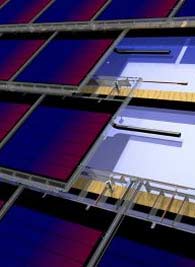A type of solar tile that can absorb sunlight to heat water and generate electricity has just been invented by an industrial designer from Australia.
 |
| Solar-powered tiles represent a shift from traditional solar power systems. (Photo: Sebastian Braat) |
This plastic tile is equipped with solar panels that connect to the home’s electrical and hot water systems. Sebastian Braat, a former student at Western Sydney University, stated that the tiles are designed for urban homes, aimed at reducing electricity bills for residents.
The tile consists of a base made from polycarbonate, featuring a water chamber and photovoltaic cells. Approximately 12-18% of the thermal energy transmitted to these photovoltaic cells is converted into electrical energy, while the remainder is used to heat water.
Braat explained that he led a cooling fluid through the water in the tile, acting as a heat exchanger. This heat exchanger will transfer heat to a circulating hot water tank.
Meanwhile, the photovoltaic cells generate direct current electricity, which flows into an inverter connected to the home’s electrical box, directly interfacing with the power grid. “If the household does not use all the electricity, it will automatically push the surplus electricity to the grid.”
Braat noted that about 200 such tiles could produce up to 1.5 kW per hour, which is more than enough for an average three-bedroom home.
However, other experts have cautioned the inventor about the efficiency of these tiles, the impact of roof slope, and their cost. Additionally, this type of roofing may be prone to leaks due to the numerous small joints.
T. An

















































